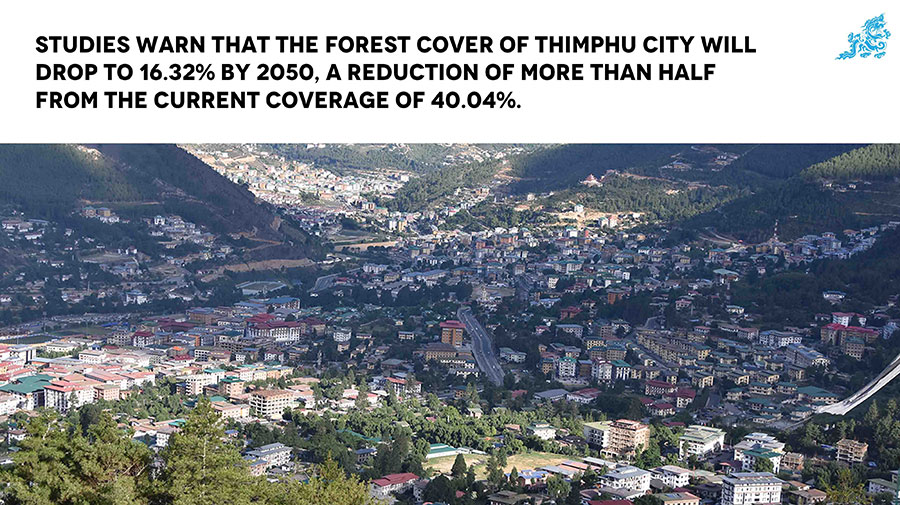Choki Wangmo
By 2050, Thimphu City’s forest cover will diminish to 16.32 percent, with a highly fragmented area of 4.28 sq km (km2), a study warns. It means that the forest cover will reduce by more than half compared to the current coverage of 40.04 percent.
The study, published earlier this year by a research professor in Korea University Sonam Wangyel Wang (PhD), revealed that under the business-as-usual scenario, prediction analysis for the year 2050 show that built-up area will consume 73.21 percent of the city area. “These findings beg for an urgent need to implement effective planning especially to protect the existing forest and water resources from further degradation.”
The loss of forest cover, according to Sonam Wangyel Wang, is expected to degrade important ecological services and increase the vulnerability of the city to landslides, gully erosion, drying of water sources, worsened air pollution, and loss of important biodiversity.
The country has experienced rapid and increasingly pronounced land use land cover (LULC) changes over the past 40 years. The change is attributed to major land-use changes in urban areas, said Sonam Wangyel Wang. “Bhutan’s LULC change from 2000 to 2013, reported that the built-up area has increased from 6 percent in 2006 to 14 percent within seven years.”
A built-up area is an area with buildings or roofed structures.
The simulation study which was conducted using remote sensing and GIS tools revealed a significant increase (12.77 percent) in the built-up area from 2002 (52.88 percent) to 2018 (65.5 percent), followed by a slight increase in the cover of bare ground.
He said that the increase in built-up areas was associated with parallel loss of important land cover types such as forest and agriculture lands and the government’s decision to expand the city towards the north and the south.
The forest cover in the dzongkhag, meanwhile, declined by 15.25 percent followed by agriculture (1.01 percent), the findings revealed.
Rapid population growth triggered by a high immigration rate of 14.5 percent, infrastructure development, rise in vehicle numbers, he said, were exerting increasing the rate of land-use changes. “Consequently, the city is grappling with classic problems of growing slums, ecosystem degradation, insufficient basic facilities including drinking water, and increasing frequency of disasters such as landslides, forest fires, and flash floods.”
According to the National Statistics Bureau, 15.75 percent of Bhutan’s total population live in Thimphu. Planned development for Thimphu started in 1985 with the establishment of the National Urban Development Commission.
Thimphu Structural Plan 2002-2027 (TSP), a long-term project spanning a period of 25 years and considered a ‘living document’ to ensure proper and efficient implementation of the plan has given significant importance to the open space system. However, Strategic Environmental Assessment for the TSP 2018 has found that the green buffer zones along major streams like Olarongchhu, Ngabirongchhu, Samtelingchhu, and Chubachhu has reduced. This is attributed in part to a 2006 government directive to reduce the buffer areas along the streams from 30 metres to 15 metres.
The simulation study recommended ecosystem-based adaptation policies and other legal frameworks that should be developed and practically implemented to protect the current forest cover. “This will help rehabilitate and improve the existing green spaces in and around the urban centres.”
The study also suggested planting fruit trees in urban spaces such as parking lots, between buildings, back yards, and along roads to increase water retention, protect soil from erosion, host biodiversity, and regulate temperature and pollution.
Sonam Wangyel Wang said that current capacities of storm drain and water reservoirs must also be enhanced while informal settlements must either be formalised by providing all basic facilities or moved to formal settlements.
“The city should restrain from landfilling flood plains and use the claimed land for building infrastructure as these areas are not only prone to flooding but also important for biodiversity,” he said.


